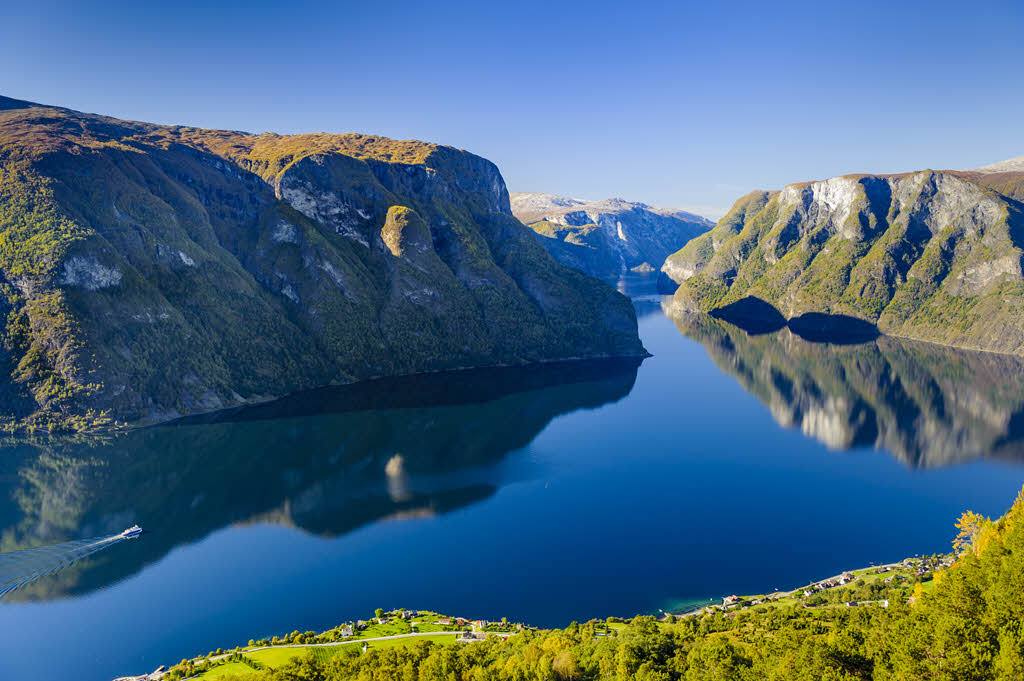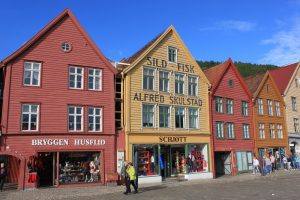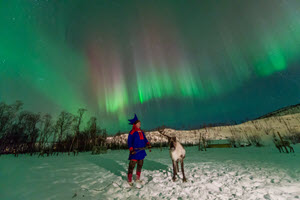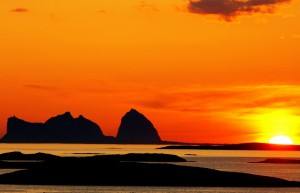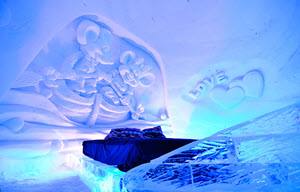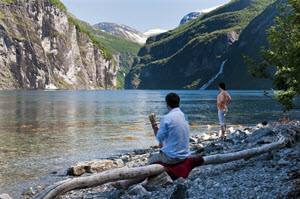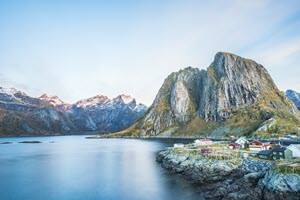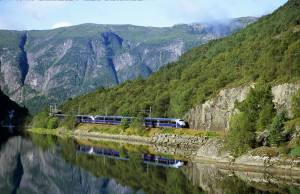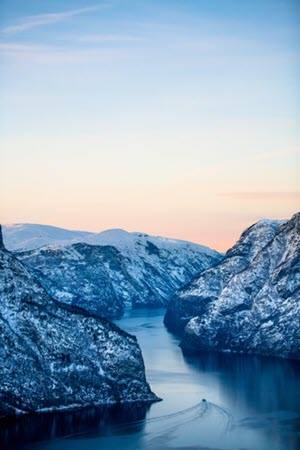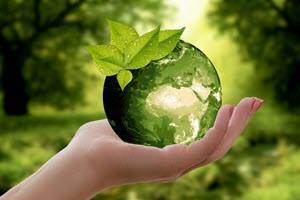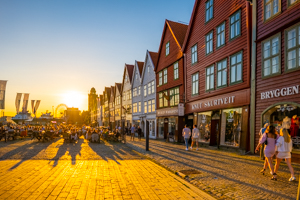About Norway – a brief introduction
Norway; a beautiful, peaceful country
located far north in mainland Europe, offering unique, natural phenomena, such as
the amazing Fjords, the long and rugged Coast, the magic Northern Lights & the exotic Midnight sun
Read more about:
• Norway’s spectacular highlights
• Norway’s constitution & values, people & economy, climate, Viking history & wildlife
• Unesco Heritage sites & culture, as well as travel planning & tours in Norway
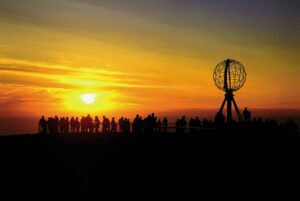
Norway’s Geography
Norway is located as far north in mainland Europe as you can get. It is part of the Scandinavian peninsula, and hosts the northernmost point of mainland Europe- the North Cape.
Norway has a very elongated shape, one of the longest and most rugged coastlines in the world, and thousands of islands off this extremely indented coastline.
Visit the North Cape on a short Cruise
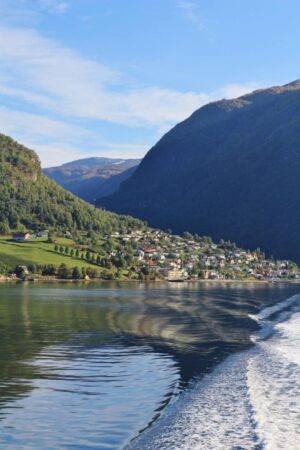
The Norwegian Fjords
A vast number of fjords are cutting their way from the coastline into the country, carved out by the ice. The main fjords are located on the western coast of southern Norway.
The Sognefjord is the longest, with several scenic branches, such as the narrow, UNESCO Naeroyfjord.
In the western Fjord Norway area you will also find the beautiful Hardangerfjord with views of the Folgefonna glacier, the scenic Nordfjord and the UNESCO Geirangerfjord.
• Read more about the fjords
• View Fjord tours & Cruises
The fjords are quite unique and beautiful, but naturally they have also been a challenge for the road planners… thus a ferry crossing the fjord is a typical sight in Norway. In fact, the ferries are defined as part of the national road system.
The ferries represent an important cultural feature of Fjord Norway. It might take time waiting for a ferry, but relaxing on board with a cup of coffee and a “svele” (thick pancake), enjoying beautiful fjord views, is worth the time!
The Hardangerfjord is still the only main fjord with a bridge crossing.
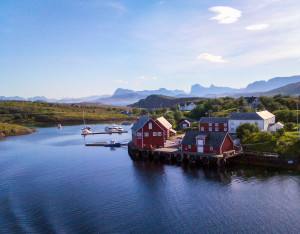
The Norwegian coast
Norway has an extensive and unique coast line, with islands, skerries, fjords, narrow passages & mountain peaks, stretching from Skagerak and the south of Norway along the North Sea to the Arctic Circle and northwards to the North Cape, the barren Finnmarken coast and the Barents Sea towards the Russian border.
The coast stretches over 2500 km, and over 83 000 km including the fjords and islands.
Norway has 239 057 registered islands! There are numerous island communities along the coast, such as the Lofoten Islands & the Unesco Vega archipelago in the north.
The Bomlo island community in western Norway, with some 12000 inhabitants, consists of more than 1000 islands!
• Read about the Norwegian coast
• View Norwegian coast Cruise packages

Arctic Norway
The Arctic northern part of Norway has a low population density, with no railroad connections north of Bodo, and relatively few roads, often closed during the winter due to heavy snowfall.
The vast Finnmarksvidda plateau with an altitude between 300 and 500 ms above sea level, is an important area for the reindeer herds of the Sami people.
View Arctic Norway tours & Cruises
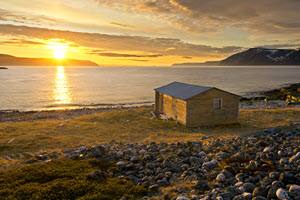
Midnight Sun & Northern Lights
North of the Arctic circle the sun does not leave the horizon during the summer months, from May to mid July, hence you can enjoy never ending bright nights and the Midnight sun – highly appreciated by the inhabitants of the north! A midnight fishing trip or a midnight mountain hike is quite common among Norwegians!
From October through March you can experience the magic Northern Lights in the northern parts of the country.
View Northern Lights tours & cruises
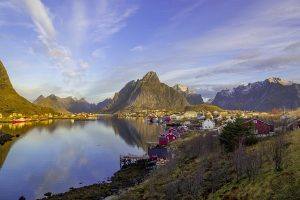
The magic Lofoten Islands
This amazing, Arctic archipelago is located north of the Arctic circle, offering stunning scenery with steep mountain peaks, Arctic fjords, tiny fishing settlements, beautiful beaches as well as a rich wildlife.
The world’s largest deep water coral reef, called the Rost Reef, is located west of Rost island
Travel to the Lofoten islands
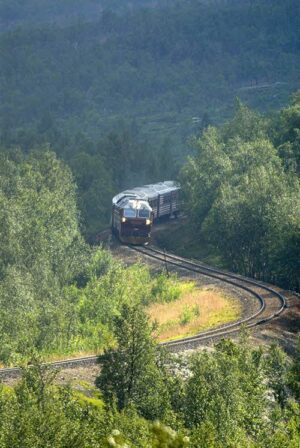
Travel in Norway
Travel planning from abroad can be a challenge due to Norway’s unique geography. This is why we have put together a large selection of travel packages in Norway, based on eco-friendly travel by public transport.
You will travel on your own (not with a group), whereas we provide detailed travel directions:
• View all our tours & cruises
• Celebrate Christmas in Norway
Book safely with Fjord Travel Norway– a local, Norwegian travel company. We have been in business for more than 20 years, offering tours based on our goal of sustainable tourism
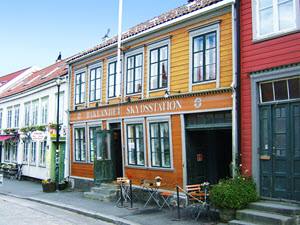
More Highlights in Norway:
• Scenic Rail lines
• Picturesque cities
• Oslo – Norway’s capital
• Ice Hotels in Norway
Highlights of Norway
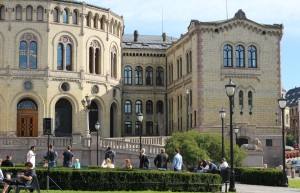
The Kingdom of Norway
is a constitutional monarchy located in Northern Europe, the western portion of the Scandinavian Peninsula.
Norway is a safe and happy country: Norway has one of the lowest crime rates in the world. The country ranks high on the World Happiness Report, ranked as number one on the OECD Better Life Index in 2019, as well as on the Democracy Index.
Norway’s values are rooted in egalitarian ideals, with the Nordic welfare model, universal health care and a comprehensive social security system.
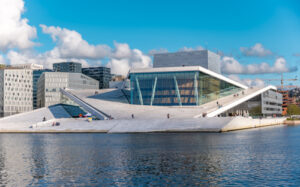 Norway’s population
Norway’s population
Norway has a population of about 5 million, and it is the second least densely populated country in Europe, with a majority living in Oslo and the eastern parts of the country.
Oslo is a charming, tiny capital with approximately 635000 inhabitants, beautifully located by the Oslo fjord, surrounded by forested hills, with easy access to nature & recreational areas.
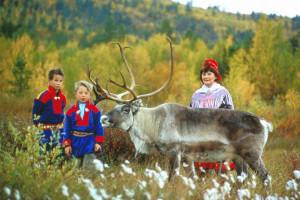
Sami people in Norway
Sami indigenous people
Norway is home to about half of the world’s Sami population, approximately 40 000. The vast majority of settlements are located in Northern Norway.
Reindeer herding is still an important way of living for many of the Sami, and they often use their traditional Sami clothing.
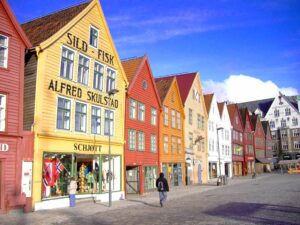
Unesco Bryggen wharf in Bergen
UNESCO sites in Norway:
The Bryggen wharf in Bergen
Urnes Stave Church
Roros mining town
Rock art of Alta
The Vega Archipelago
Struve Geodetic Arc
The Fjords; Geirangerfjord & Naeroyfjord
Rjukan-Notodden Industrial Heritage Site
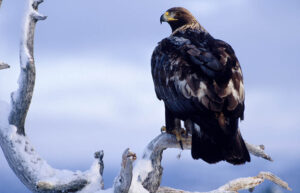
Majestic eagle!
Wildlife in Norway
The highest density of brown bears in Norway is found in the Pasvik valley, close to the former mining town of Kirkenes & the Russian border.
The Polar bear is only found at the Arctic island of Svalbard, not on mainland Norway.
Reindeer live in mountain areas throughout the country, from south to north.
A herd of Musk ox live on the Dovrefjell mountain plateau in mid Norway.
Majestic Sea eagles live along the coast, and is a common sight on island communities like the Lofoten islands in Arctic Norway & Bomlo islands on the Western coast.
Wolves live mainly in forest areas in the eastern part of Norway.
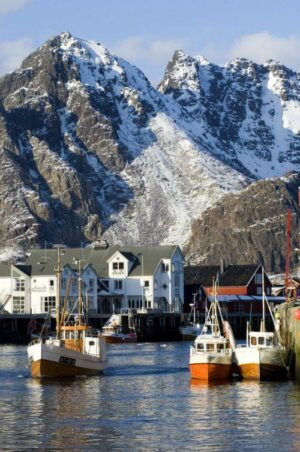
Fisheries in Norway
Fish has always played an important part in Norway’s economy, due to the vast coastline and mountains covering large areas of the country. Only the eastern parts of southern Norway has a topography suited for agriculture and larger farms.
Along the coast people typically had a minor piece of soil for a cow and some potatoes, combined with fishing.
The amazing Lofoten archipelago has always been a major area for the fisheries in Norway.
The sea surrounding the islands is rich with life, and approximately 70% of all fish caught in the Norwegian and Barents seas use the water around the islands as their breeding ground.
Even before the year 900 AD, the sagas tell about boats being equipped for the journey to the Lofoten and the winter cod fishing season, where the fishermen travelled for days and even weeks along the vaste Norwegian coast in open rowing boats and sailing boats to take part in the abundant fisheries throughout the entire winter.
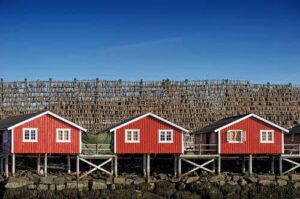
A common sight on the Lofoten islands is stockfish drying in the air and wind on wooden racks.
Stockfish is cured in a fermentation process where cold-adapted bacteria matures the fish, similar to the maturing process of cheese.
The historic stockfish trade originated in Lofoten area, travelling via Bergen to almost all European countries. For centuries, and up to modern times, stockfish actually was the most important Norwegian export item, and Italy is still the most important market for the high quality stockfish from Lofoten.
Read more about Lofoten Islands
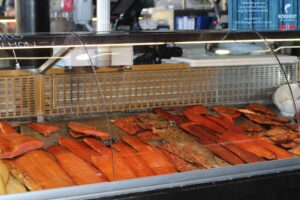
Fish farming in Norway
has become an increasingly important industry along the Norwegian coast, and smoked Norwegian salmon can be found in food stores around the globe.
The development of commercial aquaculture in Norway began around 1970; aquaculture has since then developed into a major industry in coastal areas.
Farming of Atlantic salmon is by far the most important, accounting for more than 80 percent of the total Norwegian aquaculture production.
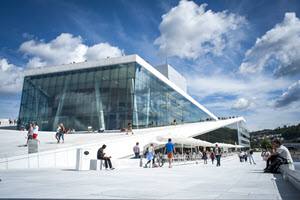
“The Oil Age”
For centuries Norway was the “poor little brother” of the Scandinavian countries, and was in fact first absorbed into a union with Denmark for centuries, and then into a union with Sweden. In 1814 Norway stood up against the union and adopted a new constitution, but had to wait until 1905 for a full independence.
Being poor for centuries, Norway did not have the economy to build monumental buildings, like those you find in Sweden and Denmark.
However, in the 1970s a new era began when it was discovered that the North Sea was filled with basins of black gold – the oil – and these days Norway is one of the richest countries in the world, thanks to the oil industry.
The increasing wages in the industry highly influenced the general income level, thus making Norway expensive for visitors from other countries.
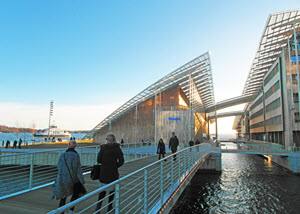
Culture in Norway
As the oil contributed to a high level of general welfare as well as income to the Norwegian government, Norway set off on a new path towards monumental buildings, like the amazing Opera House in Oslo, opened in 2008.
In 2013 Oslo decided to build a new and modern home to the famous painter Edvard Munch’s paintings, located next to the Opera House at the Bjorvika waterfront, scheduled to open in spring 2021.
The spectacular Astrup Fearnley Museum of Contemporary Art, designed by the famous Italian architect Renzo Piano, was opened in Oslo in 2012.
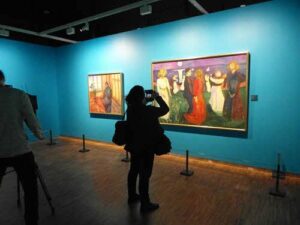
A brand new National Museum is on its way, and in 2022 the largest art museum in the Nordic countries will open in Oslo. Here you can experience older and modern art, contemporary art, architecture and design. The new museum is located by the Aker Brygge waterfront.
Among the most famous Norwegians you find the painter Edvard Munch, the poet Henrik Ibsen & the composer Edvard Grieg.
Read about scenic cities in Norway
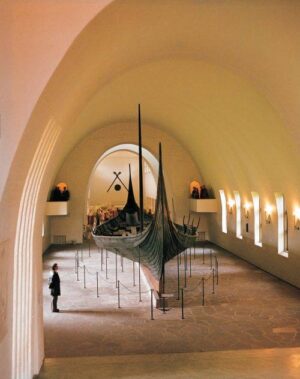
The Vikings
Norway & the Vikings. During the Viking Age (800-1050 AD) the Norwegian Vikings explored Europe through trade and warfare. With their Viking ships they traveled to the Mediterranean countries, to England, Scotland & Ireland, and as far as to America. The Viking age was characterized by expansion and immigration.
Many Norwegians left the country to live in Iceland, the Faroe Islands, Greenland and parts of Britain and Ireland. The modern-day Irish cities of Limerick, Dublin, and Waterford were founded by Norwegian settlers.
Oslo is often called the Scandinavian Viking capital. Oslo has a magnificent Viking Ship Museum with the Norwegian Viking history and magnificent Viking ships.
• Read about Oslo
• Photos of Oslo, the Viking capital
Join a real Viking feast on the Lofoten Islands
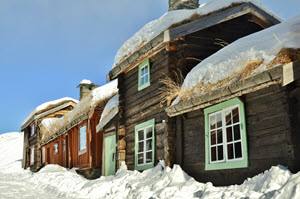
Winter in Norway at Unesco Roros
Norway’s Climate
Norway experiences warmer temperatures than one might expect at such northern latitudes, especially along the coast, with summer temperatures of around 15 to 20 degrees Celsius, and winter temperatures mostly above zero degree Celsius (+32 F). This is due to the Gulf Stream ocean current.
Even the Arctic town of Tromso does not have very cold winters, with a mean temperature in January of -3 degrees Celsius. The inner part of Norway, like the amazing Unesco Roros, experiences colder winters with snow, excellent for winter activities.
About Winter in Norway
Questions about travel in Norway?
Contact us:
• Use our contact form
• By e-mail to [email protected], or
• Call us on +47 (55) 131-310
(Mon-Fri 09:00 to 15:30 local time)

